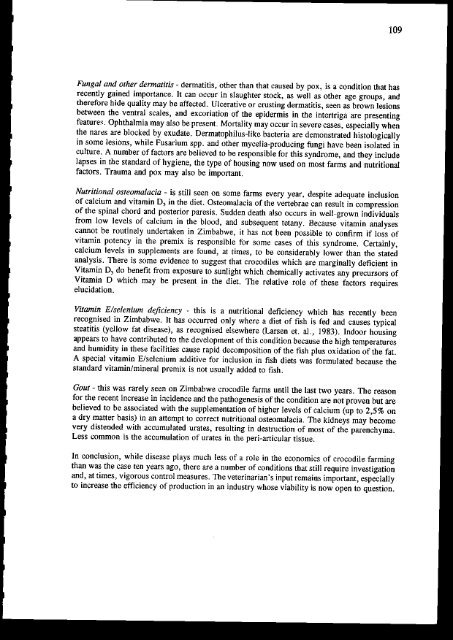size: 5036KB - Crocodile Specialist Group
size: 5036KB - Crocodile Specialist Group
size: 5036KB - Crocodile Specialist Group
You also want an ePaper? Increase the reach of your titles
YUMPU automatically turns print PDFs into web optimized ePapers that Google loves.
109<br />
Fuigol and other dermar,?ir - dermatitis, other than that caused by pox, is a condition that has<br />
recently gained importance. It can occur in slaughter stock, as well as other age groups, and<br />
therefore hide quality may be affected. Ulcerative or crusting dermatitis, seen ;b;wn lesions<br />
between the ventral scales, and excoriation of the epidermis in the intertriga are presenting<br />
features. Ophthalmia may also be present. Mortality may ocour in severe cases: especially whe;<br />
the nares are blocked by exudate. Dermatophiluslike bacteria are demonstraied'histologically<br />
insome lesions, while Fusarium spp. and other mycelia-producing fungi have been isolated in<br />
culture. A number of factorc are believed to be responsibie for thiJsyndrome, and they include<br />
lapses in the standard of hygiene, the type of housing now used on most farms and nutritional<br />
factors. Tmuma atld pox may also be imponant.<br />
Nutritional osteomalacia - is still seen on some farms evety year, despite adequate inclusion<br />
of calcium and vitamin D1 in the diet. Osteomalacia ofthe veriebrae can result in compression<br />
of the spinal chord and posterior paresis. Sudden death also occurs in well grown individuals<br />
liom low levels of calcium in the blood, and subsequent tetany. Because vitamin anzuyses<br />
cannot be routinely undertaken in Zimbabwe, it has not been possible to confirm if loss of<br />
vitamin potency in the premix is responsible fbr some cases of this syndrome. Certainly,<br />
calcium levels in supplements are fbund, at times, to be considerably lower than the stated<br />
analysis.Jhere is some evidence to suggest that crocodiles which are marginally deficient in<br />
Vitamin Dr do benefit from exposure to sunlight which chemically actiuateJ any p.ecursors of<br />
Vitamin D which may be present in the diet. The relative role of these fictors requues<br />
elucidation.<br />
Vitamin E/selenium deJiciency - this is a nutritional deficiency which has recently been<br />
recognised in Zimbabwe. It has occurred only where a diet of fi:h is fbd and causes typical<br />
steatitis (yellow fat disease), as recognised elsewhere (Latsen et. al., 19g3). Indoor housing<br />
appears to have contributed to the development ofthis condition because the high temperarures<br />
and humidity in these facilities cause rapid decomposition of the fish plus oxidation of the fat.<br />
A special vitamin E/selenium additive tbr inclusion in fish diets wa; fo.mulated because rhe<br />
standard vitamin/mineral premix is not usually added to fish.<br />
God - this was rarely seen on Zimbabwe crocodile farms until the last two years. The reason<br />
for the recent increase in incidence and the pathogenesis ofthe condition are not proven but are<br />
believed to be associated with the supplemenration of higher levels of calcium (up to 2,5% on<br />
a dry matter basis) in rm attempto correct nutritional osteomalacia. The kidneys may become<br />
very distended with accumulated urates, resulting in destruction of most of the parencnyma.<br />
Less common is the accumulation of urates in the peri-articular tissue.<br />
In conclusion, while disease plays much less of a role in the economics of crocodile farming<br />
than was the case ten yeats ago, there are a number ofconditions that still require investigation<br />
and, at times, vigorous control measuies. The veterinarian's inputremains imiortant, espeiially<br />
to inorease the efficiency of production in an industry whose viability is no\ropen to quesuoD.
















